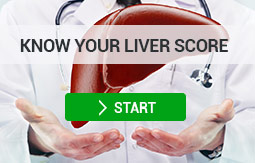What’s in this article
- About
- Signs & symptoms
- Diagnosis
- Treatment
About hepatic-steatosis
Hepatic-steatosis is the accumulation of fatty acids in the liver cells, which is also known as fatty liver disease. A small amount of fat is normal, however, if the fat takes up 5%-10% of the livers weight, you may be suffering from fatty liver disease. This can cause inflammation, prevent the liver from functioning correctly and can then lead to more serious complications such as cirrhosis of the liver.
Unfortunately, there is no medical treatment that can help fatty liver disease. However, with lifestyle changes such as healthy eating and regular exercise, fatty liver disease can stop progressing or even be reversed. Fatty liver disease is the most common liver disease in the western hemisphere and one in four in the U.S. have non-alcoholic fatty liver disease.
There are two different types of fatty liver disease, non-alcoholic and alcoholic. For non-alcoholic fatty liver, the causes are usually due to being overweight, high cholesterol or hepatitis, however, with a poor diet and lack of exercise people who are a healthy weight can also get fatty liver disease. It is seen most often in those who are middle-aged and people who suffer from non-alcoholic fatty liver disease often suffer from diabetes as well.
Alcoholic fatty liver disease is a result of excessive drinking. The recommended amount for a healthy person is one alcohol drink per day for women and two for men. According to Liver Directory alcoholic fatty liver is the first stage in alcoholic liver disease. Non-alcoholic fatty liver disease can event present itself after a short stint of heavy drinking.
Signs & symptoms
Symptoms vary for each person and often will not show until the later stage of fatty liver disease. Symptoms include:
- abdominal pain
- nausea
- fatigue
- weakness
- loss of appetite
- confusion or trouble concentrating
Diagnosis
Fatty liver disease can be diagnosed in several different ways. A blood sample is taken by your doctor and if a certain number of enzymes are present this could point towards a fatty liver. A biopsy can be taken by inserting a needle into the skin to retrieve a part of the liver or alternatively you can have an ultrasound. You can discuss the best diagnosis option with your doctor or physician.
Treatment
As stated before, there is no medical treatment available for fatty liver disease. Instead, it is recommended that you follow a healthy lifestyle. Take up a sport or join a club to increase your fitness levels and if you are overweight, to lose weight. Ensure you always stay hydrated as hydration is vital for a good functioning liver. Eat a healthy balanced diet, make sure you do not skip meals and always have a high fiber breakfast such as fruit and oatmeal. If you are a smoker you should stop, talk to your doctor about your options. Alcohol should also be avoided, just one night of heavy drinking can harm your liver, if you already have a liver disease you should avoid alcohol consumption altogether.
Find out more about the basics of liver health with Dr. Tarek Hassanein, M.D.
References
www.amsety.com
www.sciencedirect.com
www.liverdirectory.com
www.cdc.gov

 (442) 244-5115
(442) 244-5115













